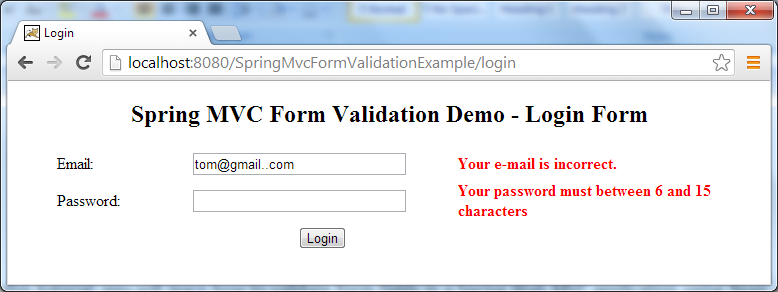You will also see how to display the error message on the screen so that the user can re-enter input to make it be valid. Let’s take a look at them one by one.

But, after upgrading to latest version, annotations broke. Valid annotation is not working in spring. In other words, annotations are used to provide supplemental information about a program.
It is not a part of the application that we develop. It does not have a direct effect on the operation of the code they annotate. When handling input of a user, validation is a common task. In fact, it’s so common, that there’s even a specification for it called JSR 3bean validation and JSR-3which contains version of the same specification.
Spring Boot Annotations. Creating a custom validation annotation is pretty easy. In this post, you will learn how to create a custom constraint annotation and a corresponding validator class. Advertisement Setup of.
Ask Question Asked years, months ago. Viewed 7times 0. When the validation fails, the default error message will be returned to the client. The default error message is a generic error message that does not make sense in certain api calls.
The message must be tailored for a particular api request. After this we will check our validation by putting a future date for Date-Of-Birth field. It implements all the basic features of a core spring framework like Inversion of Control, Dependency Injection.

JSR-3implementation (such as Hibernate validator) is on the classpath. It can be set for a specific DataBinder instance and implement validation without annotations (non-declarative approach).
We will perform almost all kinds of validations. Annotation is a form of metadata which provides data about a program that is not part of the program itself. Annotations do not have direct effect on the operation of the code they annotate.
The method validation feature supported by Bean Validation 1. However, to validate them we need to follow a couple of more steps. First, let’s take a look at our application. Maven Dependencies.
Validating a request is a critical component of a Great REST API. Make sure the following dependencies reside on the class-path. All these annotations come from the javax. For the complete list of Java Bean Validation annotations, see this page.
Naturally, for checking more specific conditions, there is the possibility of creating custom annotations and validators. This ensures that the incoming object is validated. Otherwise, you’ll have to include org. In this case we’re validating an API request to create a product in our system (in ProductController.java).
Create a spring boot application with required dependencies. Add spring - boot -starter-web and Lombok(To reduce boilerplate code) dependencies to the pom. Standard validation annotations are enough for most scenarios, but not always. Sometimes the validation logic is just too complicated to implement using the standard annotations.
These are called custom annotations. JSR-3bean validation is a specification whose objective is to standardize the validation of Java beans through annotations. You can use JSR 3Bean Validation javax. The objective of the JSR-3standard is to use annotations directly in a Java bean class.
This allows validation rules to be specified directly in the code they are intended to validate, instead of creating validation rules in separate classes. So far we learned about. In this article, we’ll go over how you can easily add validation to any form without jumping through JQuery hoops.
I have all the code for this tutorial on.
Aucun commentaire:
Enregistrer un commentaire
Remarque : Seul un membre de ce blog est autorisé à enregistrer un commentaire.